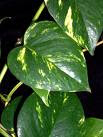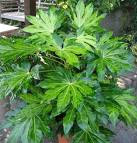Some of you are amazed that I have numerous potted plants growing happily in my home-room.
Some of you came to ask me if I take them out into the sun later and whether my plants are getting enough sunlight for photosynthesis. Thank you for the concern you have for my plants.
Many of us assume that all plants need direct sunlight for photosynthesis.
Shade plants (like the ones I have in my home room) are also found in nature and they are usually found on the forest floors, under the tall trees that form the canopy. The light that reaches the undergrowth and ground cover plants is filtered, diffused or scattered and dim.
These shade-loving plants have adapted to maximise whatever available sunlight they get. Most ferns, mosses and epiphytes (plants that grow in the crooked places in the trees) are shade plants. These are places where branches join the tree trunks are also places where dead leaves collect and decay to form compost. Ferns will send down roots into the compost for mineral nutrition and water.
Light is not a limiting factor even at very low intensities in these plants. This means that the chloroplasts (in the leaves of these plants) are able to photosynthesise efficiently even at low light intensities.
How many of the following shade plants are familiar to you? You can start growing them in your own homes once you know their requirements. If you can mimic their natural habitats as closely as you possibly can, they will thrive and give you hours of pleasure. Many flat dwellers keep potted plants in the common corridor but you can keep plants in your room if you choose the right kinds. Remember, as long as they get daylight from a window, they do not need direct sun.
 Stag horn ferns, another common epiphyte with antler or horn-like fronds which hang downwards. Stag horn ferns, another common epiphyte with antler or horn-like fronds which hang downwards. |
 Peace lily, Spathyphyllum, has sail-like flowers which are used in cut-flower displays. Peace lily, Spathyphyllum, has sail-like flowers which are used in cut-flower displays. |
  Money plant, lucky plant, Epipremnum aureum, has heart-shaped leaves. It is a very hardy plant that thrives even with minimum care. Money plant, lucky plant, Epipremnum aureum, has heart-shaped leaves. It is a very hardy plant that thrives even with minimum care. |
  Zz plant or jing qian shu, Zamioculus zamiofolia, is extremely hardy, good plant to grow for people with no green fingers. Zz plant or jing qian shu, Zamioculus zamiofolia, is extremely hardy, good plant to grow for people with no green fingers. |
  Peperomia, is an ideal table top plant. Peperomia, is an ideal table top plant. |
  Draceaena, iron wood plant, is a hardy plant that does not need much attention. Draceaena, iron wood plant, is a hardy plant that does not need much attention. |
  Philodendron, is an ideal shade plant. Philodendron, is an ideal shade plant. |
  Monsteria delicosa, fruit-salad plant, has slits in the large leaves. It grows luxuriantly in dim light but will not flower in dim light. But once placed in direct sunlight, it will do so. Monsteria delicosa, fruit-salad plant, has slits in the large leaves. It grows luxuriantly in dim light but will not flower in dim light. But once placed in direct sunlight, it will do so. |
  Aglaonema, is a beautiful, colourful plant with many varieties which are much sought after. Aglaonema, is a beautiful, colourful plant with many varieties which are much sought after. |
 Fatsia, has large lobed leaves and it is an ideal shade plant. Fatsia, has large lobed leaves and it is an ideal shade plant. |
A bit of trivia here:
Do you know that a potato plant has about 20% common DNA material as man?
Do you know that the chlorophyll molecule is very similar to the haemoglobin molecule in man? Presence of magnesium (green) or iron (red) is the main (metallic) difference it seems.
I hope you will look at plants with more reverence now that you know this... I hope.
Cheers
Postscript:
Do you know the answers to these questions on plants?
- Why do some plants have small leaves and others large?
- Why do some plants have simple leaves and others compound?
- Why is it that money plant has small leaves when it forms the ground cover but it becomes about 100 times larger and produces slits and becomes divided when it climbs up into a tall tree's canopy?
- Why are young leaves usually orangey or yellowish in colour?
- Why do leaves turn reddish on the tree when they die?
- Why does the mangrove trees' leaves have salt crystals on their under surfaces?
- Why are some leaves shiny and waxy and others matt?
- Why do some plants have hairy leaves and others smooth ones?
- Can you name some green plants which have special leaves which are not green?
- Algae depend on sunlight for photosynthesis. However they come in many colours besides green, such as blue-green, red, purple-green, etc? Only green plants can carry out photosynthesis?
Why not google for the answers on your own rather then wait for me?





Thanks for the info, really helpful
ReplyDeletePotted Plants